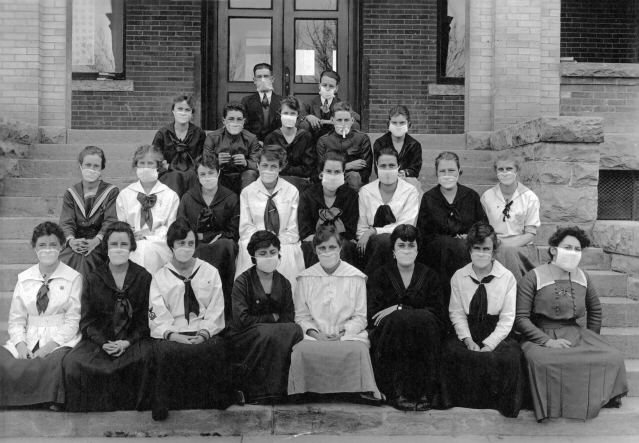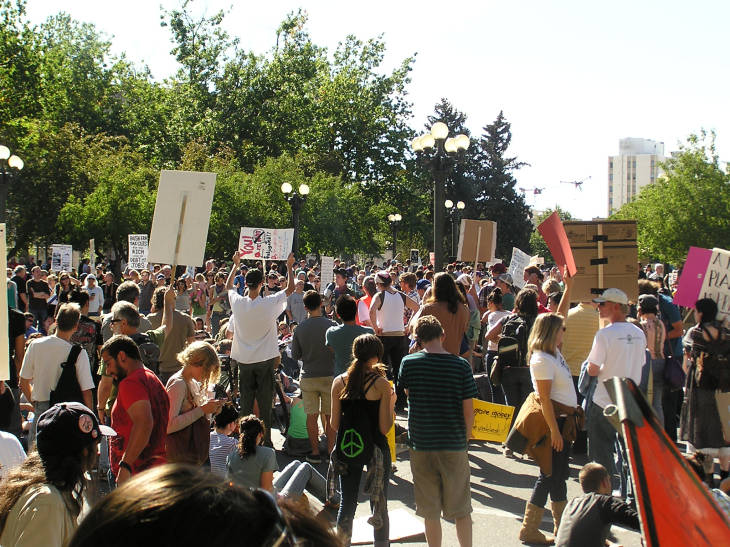Story
After You Wash Your Hands and Put on a Mask, What Can Save You Next?
History can.
The link between coronavirus and our past isn’t just one straight line to a single disaster or worldwide pandemic. It's a diffuse connection to a number of moments in our history when people were faced with what seemed like overwhelming odds, beyond their control, and they came to realize the best solution was to try and get organized.
Speaking a couple of years after the bank crash of 2008, economist Richard Wolff remarked that most of the time, when people needed to get through an upheaval in their lives—personal or political—what they needed first were words and pictures to help them understand the thing. Almost always, Wolff said, the language and imagery are borrowed from a historic calamity: convenient phrases, images, and metaphors from a relatable past point of departure that could help describe the plight they had suddenly found themselves in.
“We compare [the 2008] crisis with the last time . . . [and] that’s the 1930s. And that had to be brought back because that’s the only standard, the equivalent we have to make sense of what we’re going through now,” said Wolff. “Like with everybody, you make sense of a crisis now if you can think of a similar crisis that you, or your friends, or your family went through at some other point. It’s what we do.”
If we’re looking right now for an equivalent to 2020, by far the easiest comparison is to the flu pandemic of 1918: a never-before-encountered respiratory sickness that came from an animal and spread rapidly over the rest of the planet, while in the States its effects exposed an unsound medical system and lack of preparation and understanding from government officials. In fact, Denver’s experience with the 1918 pandemic is a prime example of what could happen today if the government and businesses are in too much of a hurry to give an all-clear.

The Cañon City High School class of 1919 poses for a class picture wearing surgical masks during the Spanish flu pandemic, which hit Colorado in 1918–19.
But there’s an element of the unreal that also makes direct comparisons more difficult. Between what we’re seeing or hearing on the one hand—wrecked lives, pleading emails from local businesses; every day more new diagnoses, more deaths, and breathless declarations the virus now “will change everything”—and what we come across in our day-to-day makes things seem jarring, and unreal; the lights come on, we can take a hot shower, and if you give it a couple of days, there’s usually kitty litter and peanut butter at King Soopers. You can also still go online to shop for entertainment and distraction, for snacks and hand sanitizer (or tactical sights for your .30-06 rifle, 40% off on Amazon), and post updates to social media.
Outside the virtual, outside of quarantine, are the disasters. The thing is, though, they weren’t unknown to us. And maybe that’s the most jarring thing: before coronavirus, trying to see a doctor for a life-threatening illness was already a crapshoot on so many levels, and a majority of us were already a paycheck away from being evicted or losing our cars; before coronavirus, the mega-wealthy could already flee society’s crackups in a tricked-out bunker or float away from it all on their superyachts, while far too many of us were living lives way out of step with theirs. The last two months of the outbreak in the States, writes author Ben Burgis, have become “an index of social rot,” with the pandemic making problems of power and inequality in our communities even more stark than they were before.

Unemployed workers under the banner of Coxey's Army demonstrate in downtown Denver in 1894 in the wake of the silver crash and the waning days of the Gilded Age, demanding jobs.
So if we look for words and pictures to help us make sense of crisis, in the case of coronavirus, what we should do is look into those gaps, what’s been happening in the ongoing convulsions of the last forty-plus years that many historians and economists were saying had become a second Gilded Age, that’s been laid bare by the pandemic. This means that connecting coronavirus to our past isn’t just one straight line to a single disaster or worldwide pandemic, but to a diffuse number of moments in our history, when people were faced with what seemed like overwhelming odds, beyond their control, and they came to realize the best solution was to try and get organized.
One of these moments was in 1932, at the height of the Great Depression, the literal granddaddy of all crises of the last one hundred years. A former architect and “self-styled loyal patriot” named Charles Dunwoody started an Unemployed Citizens League, based on a group that workers in Seattle had begun, “aimed at cooperative productions and the exchange of skills as members sought to survive within the existing society,” writes Denver historian Phil Goodstein. Though it “existed as a temporary alliance until the good times returned,” Goodstein says, “For a couple of years, the League soared . . . [showing] 84 different occupations . . . and [claiming] to have reached out to approximately 34,000 members in a Denver of about 300,000 residents.”
Occupy Denver was a more recent example of everyday people pushing back against forces that seemed well out of their control. Starting in September of 2011, activists hopscotched between Lincoln Park, across from the Capitol, and Civic Center park, protesting gentrification, homelessness, and the growing inequality in Colorado and Denver. The creation of the activist group Denver Homeless Out Loud, which has been on the frontlines of Denver’s ongoing housing plight (yet another crisis!), was one of the eventual outcomes of the Occupy protests.
In the 1970s, disillusioned health care worker and Presbyterian minister Wade Blank saw a crisis in how Denver, and the rest of the country, were failing to help disabled people live full, dignified lives. He founded the Atlantis Community, an organization “to provide as many of life’s necessities—the necessities often taken for granted by those who do not live with a physical or mental disability—as possible,” writes Denver Public Library researcher Katie Rudolph. To make demands for real change in the midst of this crisis, “Blank and those who resided at Atlantis decided to form an activist group to garner as much attention as possible for disability rights—ADAPT (American Disabled for Attendant Programs Today).” ADAPT famously protested public transport in Denver, but also to expand government health and welfare policies for people with disabilities.

Laura Hershey takes part in the ADAPT protest against the American Health Care Association's 1994 Las Vegas convention.
-->“Ride or Die” with Denver’s Gang of 19 in the new episode of Lost Highways from History Colorado Studios
In the spring of 1987, New York author Larry Kramer and about 300 other activists started a “horizontal” (mostly leaderless) direct-action group, AIDS Coalition to Unleash Power (ACT UP), to enact or change public health policies and raise awareness about the pandemic. However, grassroots AIDS activism across the country had already been gathering momentum. One example of that shift in consciousness happened in Denver at the Gay and Lesbian Health Conference in the summer of 1983. With a manifesto called the “Denver Principles,” activists at the conference planned a network of groups of persons with AIDS across every major city in the country, the “National Association of People With AIDS.” After the conference, local representatives of PWA in Denver were active in lobbying the state legislature on health and AIDS-related issues, becoming the public face of the disease in the city.
The value that comes from the words and pictures we get from history, Richard Wolff says, isn’t just in making sense of how things have gone wrong, but also how we can act in the present. In the case of the Great Depression, Wolff points out that “An interesting thing happened in the 1930s . . . [their crisis] lasted for years, for twelve years. But there was a big difference [between 2008 and the ’30s] . . . the mass of people reacted, and got involved.” This meant, Wolff says, “People in the streets. There were demonstrations of tens of thousands, and sometimes hundreds of thousands, in [New York’s] Union Square.”
Sure, social distancing makes a rally of tens of thousands for Denver’s grocery store workers or for Aurora’s Amazon warehouse employees or for renters in Civic Center a little harder, but the past also directs us to creative ways of making ourselves heard. People have done so, collectively, and in much more dangerous and unbearable situations than the one we're living in, even under quarantine and all the feelings of instability and despair that have come with it.
Future historians, to coin a phrase, will look back and shake their heads if the legacy of spring 2020 ends up a referendum on the usefulness of cloth masks instead of the era's monstrous inequality, which became even more destructive after the COVID pandemic began. Like Richard Wolff points out, and as the Gang of 19, the Denver Unemployment League, Occupy, PWA, and so many others have already demonstrated, history's already given us the permission to react in a crisis, to get involved in a crisis, to get out and demonstrate in crisis—and most importantly, we do it for one another.

